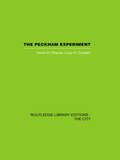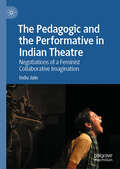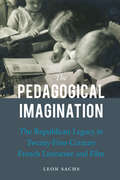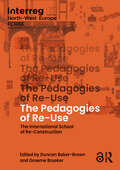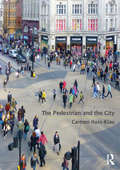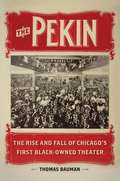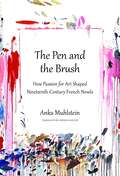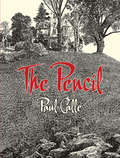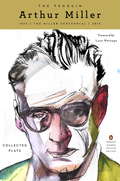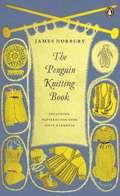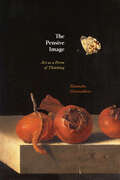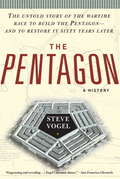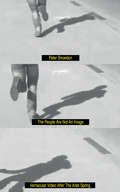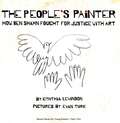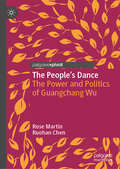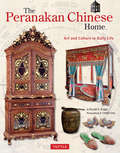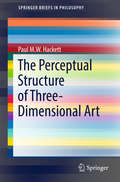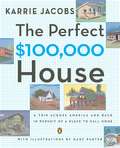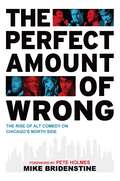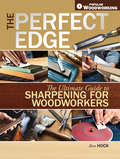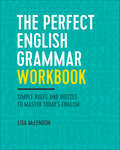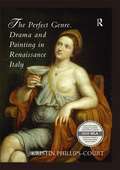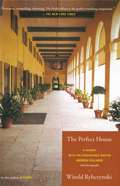- Table View
- List View
The Peckham Experiment: A study of the living structure of society
by Innes H. Pearse Lucy H. CrockerFirst published in 2006. Routledge is an imprint of Taylor & Francis, an informa company.
The Pedagogic and the Performative in Indian Theatre: Negotiations of a Feminist Collaborative Imagination
by Indu JainThis book foregrounds the realm of Contemporary Indian Feminist Theatre in order to explore the inter-relationships between feminist theatrical theory, practice and its historical antecedents. The study focuses on the performance processes, training methods and pedagogical vocabulary used by four Indian women directors: Anamika Haksar, Anuradha Kapur, Kirti Jain and Tripurari Sharma. The book interprets the feminist emphasis on process as extended into actor training and rehearsal dynamics, investigating its innovations as well as limitations, while examining how successful these director-pedagogues were in bringing gendered and radical feminist sensibilities to their work in classroom spaces.
The Pedagogical Imagination: The Republican Legacy in Twenty-First-Century French Literature and Film
by Leon SachsFrench school debates of recent years, which are simultaneously debates about the French Republic’s identity and values, have generated a spate of internationally successful literature and film on the topic of education. While mainstream media and scholarly essays tend to treat these works as faithful representations of classroom reality, The Pedagogical Imagination takes a different approach. In this study of French education and republicanism as represented in twenty-first-century French literature and film, Leon Sachs shifts our attention from “what” literature and film say about education to “how” they say it. He argues that the most important literary and filmic treatments of French education in recent years—the works of Agnès Varda, Érik Orsenna, Abdellatif Kechiche, François Bégaudeau—do more than merely depict the present-day school crisis. They explore questions of education through experiments with form.The Pedagogical Imagination shows how such techniques engage present-day readers and viewers in acts of interpretation that reproduce pedagogical principles of active, experiential learning—principles at the core of late nineteenth-century educational reform that became vehicles for the diffusion of republican ideology.
The Pedagogies of Re-Use: The International School of Re-Construction
by Graeme Brooker Duncan Baker-BrownThe Pedagogies of Re-Use captures the amazing digital gathering of students, academics, practitioners, and activists that happened at the International School of Re-Construction. Involving over 100 people, from countries as far apart as Brazil, Canada, Ireland, UK, Spain, Germany, Greece, UAE, and China, the participants spent two weeks working in eleven teams to consider architectural propositions responding to the current climate and ecological emergency. This book documents the work of the eleven teams, considering the themes they pursued, the student projects proposed, and the final design ideas developed by each group. Supplemented with images of the work, the book also includes leading academics and professionals who supported the school and contribute their voices to these crucial issues of deconstruction, re-use, and adaptation. It is ideal reading for students and academics looking at the issues created by the climate emergency to which architecture must respond.The Pedagogies of Re-Use is part of an EU ERDF £4.33 million Interreg NWE project entitled ‘Facilitating the Circulation of Reclaimed Building Elements’ (FCRBE), Interreg NWE 739, October 2018– December 2023. Online publication: June 2024, London.The FCRBE project aims to increase the amount of reclaimed building elements in circulation within its territory by +50% (in mass) by 2032.http://www.nweurope.eu/fcrbe
The Pedestrian and the City
by Carmen Hass-KlauThe Pedestrian and the City provides an overview and insight into the development, politics and policies on walking and pedestrians: it includes the evolution of pedestrian-friendly housing estates in the 19th century up to the present day. Key issues addressed include the struggle of pedestrianization in town centers, the attempts to create independent pedestrian footpaths and the popularity of traffic calming as a powerful policy for reducing pedestrian accidents. Hass-Klau also covers the wider aspects of urban and transport planning, especially public transport, essential for promoting a pedestrian-friendly environment. The book includes pedestrian-friendly policies and guidelines from a number of European countries and includes case studies from the UK, Germany, Britain, France, Spain, Italy, the Netherlands, Denmark, the US and Canada, with further examples from ten additional countries. It also contains a unique collection of original photographs; including ‘before’ and ‘after’ photos of newly introduced pedestrian-friendly transport policies. As the pedestrian environment has become ever more crucial for the future of our cities, the book will be invaluable to students and practicing planners, geographers, transport engineers and local government officers.
The Pekin: The Rise and Fall of Chicago's First Black-Owned Theater
by Thomas BaumanIn 1904, political operator and gambling boss Robert T. Motts opened the Pekin Theater in Chicago. Dubbed the "Temple of Music," the Pekin became one of the country's most prestigious African American cultural institutions, renowned for its all-black stock company and school for actors, an orchestra able to play ragtime and opera with equal brilliance, and a repertoire of original musical comedies. A missing chapter in African American theatrical history, Bauman's saga presents how Motts used his entrepreneurial acumen to create a successful black-owned enterprise. Concentrating on institutional history, Bauman explores the Pekin's philosophy of hiring only African American staff, its embrace of multi-racial upper class audiences, and its ready assumption of roles as diverse as community center, social club, and fundraising instrument. The Pekin's prestige and profitability faltered after Motts' death in 1911 as his heirs lacked his savvy, and African American elites turned away from pure entertainment in favor of spiritual uplift. But, as Bauman shows, the theater had already opened the door to a new dynamic of both intra- and inter-racial theater-going and showed the ways a success, like the Pekin, had a positive economic and social impact on the surrounding community.
The Pen and the Brush: How Passion for Art Shaped Nineteenth-Century French Novels
by Adriana Hunter Anka MuhlsteinA scintillating glimpse into the lives of acclaimed writers and artists and their inspiring, often surprising convergences, from the author of Monsieur Proust's Library With the wit and penetration well known to readers of Balzac's Omelette and Monsieur Proust's Library, Anka Muhlstein's PEN AND BRUSH revisits the delights of the French novel. This time she focuses on late 19th- and 20th-century writers--Balzac, Zola, Proust, Huysmans, and Maupassant--through the lens of their passionate involvement with the fine arts. She delves into the crucial role that painters play as characters in their novels, which she pairs with an exploration of the profound influence that painting exercised on the novelists' techniques, offering an intimate view of the intertwined worlds of painters and writers at the time. Muhlstein's deftly chosen vignettes bring to life a portrait of the nineteenth century's tight-knit artistic community, where Cézanne and Zola befriended each other as boys and Balzac yearned for the approval of Delacroix. She leads the reader on a journey of spontaneous discovery as she explores how a great painting can open a mind and spark creative fire.
The Pencil
by Paul Calle Chris CalleA showcase of pencil works by a master of the medium, this volume explains Paul Calle's process and provides a fantastic gallery of demonstrations and inspiration for artists at intermediate to advanced levels. Calle — whose clients have included NASA, the National Park Service, Ladies' Home Journal, and the U.S. Postal Service — explores pencil drawing as a serious medium rather than just a preliminary to painting. Starting with a brief history of the development of the pencil and its use by celebrated artists of the past, Calle discusses tools and materials before introducing a series of demonstrations. Lavishly illustrated chapters examine form, figure drawing, sketching, drawing from nature, perspective, and more, including tips on doing trial renderings of key sections of a picture, making corrections, handling perspective and composition, and using photography and other drawing aids. This new edition brings The Pencil, Calle's most defining book on working in graphite, back in to circulation after 25 years. It features revisions and updates by the author's son Chris Calle, who is also an accomplished artist and illustrator. Students and teachers as well as serious beginners who want to draw in a realistic style will appreciate this opportunity to sharpen their pencil techniques.
The Penguin Arthur Miller
by Arthur Miller Lynn NottageTo celebrate the centennial of his birth, the collected plays of America's greatest twentieth-century dramatist in a beautiful bespoke hardcover edition In the history of postwar American art and politics, Arthur Miller casts a long shadow as a playwright of stunning range and power whose works held up a mirror to America and its shifting values. The Penguin Arthur Miller celebrates Miller's creative and intellectual legacy by bringing together the breadth of his plays, which span the decades from the 1930s to the new millennium. From his quiet debut, The Man Who Had All the Luck, and All My Sons, the follow-up that established him as a major talent, to career hallmarks like The Crucible and Death of a Salesman, and later works like Mr. Peters' Connections and Resurrection Blues, the range and courage of Miller's moral and artistic vision are here on full display.This lavish bespoke edition, specially produced to commemorate the Miller centennial, is a must-have for devotees of Miller's work. The Penguin Arthur Miller will ensure a permanent place on any bookshelf for the full span of Miller's extraordinary dramatic career.The Penguin Arthur Miller includes: The Man Who Had All the Luck, All My Sons, Death of a Salesman, An Enemy of the People, The Crucible, A View from the Bridge, After the Fall, Incident at Vichy, The Price, The Creation of the World and Other Business, The Archbishop's Ceiling, The American Clock, Playing for Time, The Ride Down Mt. Morgan, The Last Yankee, Broken Glass, Mr. Peters' Connections, and Resurrection Blues.From the Hardcover edition.
The Penguin Knitting Book
by James NorburyThe Penguin Knitting Book by James Norbury is a charming how-to-knit classic packed with delightfully vintage advice.Knitting fills a fascinating page in the human story. I know of no home-craft that enjoys the universal popularity of hand-knittingJames Norbury's The Penguin Knitting Book, first published in 1957, is a how-to guide for the experienced knitter as well as the beginner. Full of wit and charm as well as tips and techniques for the contemporary knitter, The Penguin Knitting Book entertainingly illustrates all things vintage in the world of wool.Along with telling you how to knit, The Penguin Knitting Book includes original vintage patterns for every member of the family. Babies' coats, pullovers for father, sweaters for the teenager, dresses, jumpers, coats and cardigans, you will find them all in this charming aid to better knitting.'James Norbury was the strongest single influence in British knitting during the twenty-five years after the Second World War' Sir Bishop Richard Rutt, author of A History of Hand Knitting'[In the late 1960s] there was a chap called James Norbury, who had his own knitting show on the BBC. I sat in on some of the programmes, and good stuff it was, too. I learned lots of racy stuff about 'knit one, purl one'' Sir David Attenborough'Knitting is the saving of a life' Virginia WoolfJames Norbury wrote The Penguin Knitting Book in 1957. He travelled extensively throughout the world, studying every aspect of the knitter's craft. A knitting historian, teacher and designer as well as a television star on his own BBC knitting show, he was Chief Designer for Patons and one of the foremost authorities on the history of knitting.
The Pensive Image: Art as a Form of Thinking
by Hanneke GrootenboerGrootenboer considers painting as a form of thinking in itself, rather than a subject of philosophical and interpretive thought. While the philosophical dimension of painting has long been discussed, a clear case for painting as a form of visual thinking has yet to be made. Traditionally, vanitas still life paintings are considered to raise ontological issues while landscapes direct the mind toward introspection. Grootenboer moves beyond these considerations to focus on what remains unspoken in painting, the implicit and inexpressible that manifests in a quality she calls pensiveness. Different from self-aware or actively desiring images, pensive images are speculative, pointing beyond interpretation. An alternative pictorial category, pensive images stir us away from interpretation and toward a state of suspension where thinking through and with the image can start. In fluid prose, Grootenboer explores various modalities of visual thinking— as the location where thought should be found, as a refuge enabling reflection, and as an encounter that provokes thought. Through these considerations, she demonstrates that artworks serve as models for thought as much as they act as instruments through which thinking can take place. Starting from the premise that painting is itself a type of thinking, The Pensive Image argues that art is capable of forming thoughts and shaping concepts in visual terms.
The Pentagon: The Untold Story of the Wartime Race to Build the Pentagon--and to Restore It Sixty Years Later
by Steve VogelThe creation of the Pentagon in seventeen whirlwind months during World War II is one of the great construction feats in American history, involving a tremendous mobilization of manpower, resources, and minds. In astonishingly short order, Brigadier General Brehon B. Somervell conceived and built an institution that ranks with the White House, the Vatican, and a handful of other structures as symbols recognized around the world. Now veteran military reporter Steve Vogel reveals for the first time the remarkable story of the Pentagon's construction, from it's dramatic birth to its rebuilding after the September 11 attack. At the center of the story is the tempestuous but courtly Somervell-"dynamite in a Tiffany box," as he was once described. In July 1941, the Army construction chief sprang the idea of building a single, huge headquarters that could house the entire War Department, then scattered in seventeen buildings around Washington. Somervell ordered drawings produced in one weekend and, despite a firestorm of opposition, broke ground two months later, vowing that the building would be finished in little more than a year. Thousands of workers descended on the site, a raffish Virginia neighborhood known as Hell's Bottom, while an army of draftsmen churned out designs barely one step ahead of their execution. Seven months later the first Pentagon employees skirted seas of mud to move into the building and went to work even as construction roared around them. The colossal Army headquarters helped recast Washington from a sleepy southern town into the bustling center of a reluctant empire. Vivid portraits are drawn of other key figures in the drama, among them Franklin D. Roosevelt, the president who fancied himself an architect; Secretary of War Henry L. Stimson and Army Chief of Staff General George C. Marshall, both desperate for a home for the War Department as the country prepared for battle; Colonel Leslie R. Groves, the ruthless force of nature who oversaw the Pentagon's construction (as well as the Manhattan Project to create an atomic bomb); and John McShain, the charming and dapper builder who used his relationship with FDR to help land himself the contract for the biggest office building in the world. The Pentagon's post-World War II history is told through its critical moments, including the troubled birth of the Department of Defense during the Cold War, the tense days of the Cuban Missile Crisis, and the tumultuous 1967 protest against the Vietnam War. The pivotal attack on September 11 is related with chilling new detail, as is the race to rebuild the damaged Pentagon, a restoration that echoed the spirit of its creation. This study of a single enigmatic building tells a broader story of modern American history, from the eve of World War II to the new wars of the twenty-first century. Steve Vogel has crafted a dazzling work of military social history that merits comparison with the best works of David Halberstam or David McCullough. Like its namesake, The Pentagon is a true landmark. "Among books dealing with seemingly impossible engineering feats, this easily ranks with David McCullough's The Great Bridge and The Path Between the Seas, as well as Ross King's Brunelleschi's Dome. " -Kirkus Reviews (Starred Review) "Vogel artfully weaves architectural and cultural history, thus creating a brilliant and illuminating study of this singular (and, in many ways, sacred) American space. " -Publishers Weekly (Starred Review) "An amazing story, expertly researched and beautifully told. Part history, part adventure yarn, The Pentagon is above all else the biography of an American icon. "
The People Are Not an Image: Vernacular Video After the Arab Spring
by Peter SnowdonA major intervention in media studies theorizes the politics and aesthetics of internet videoThe wave of uprisings and revolutions that swept the Middle East and North Africa between 2010 and 2012 were most vividly transmitted throughout the world not by television or even social media, but in short videos produced by the participants themselves and circulated anonymously on the internet.In The People Are Not An Image, Snowdon explores this radical shift in revolutionary self-representation, showing that the political consequences of these videos cannot be located without reference to their aesthetic form. Looking at videos from Tunisia, Bahrain, Syria, Libya, and Egypt, Snowdon attends closely to the circumstances of both their production and circulation, drawing on a wide range of historical and theoretical material, to discover what they can tell us about the potential for revolution in our time and the possibilities of video as a genuinely decentralized and vernacular medium.
The People's Painter How Ben Shahn Fought for Justice with Art: How Ben Shahn Fought For Justice With Art
by Cynthia LevinsonAs an observant child growing up in Lithuania, Ben Shahn yearns to draw everything he sees-and, after seeing his father banished by the Czar for demanding workers’ rights, he develops a keen sense of justice, too. So, when Ben and the rest of his family make their way to America, Ben brings both his sharp artistic eye and his desire to fight for what’s right. As he grows, he speaks for justice through his art-by disarming classmates who bully him because he’s Jewish, by defying his teachers’ insistence that he paint beautiful landscapes rather than true stories, by urging the US government to pass Depression-era laws to help people find food and jobs.
The People’s Dance: The Power and Politics of Guangchang Wu (Critical Studies in Dance Leadership and Inclusion)
by Rose Martin Ruohan ChenThis book presents an analysis of how the grassroots movement of Guangchang Wu or ‘square dance’ in China has become a national phenomenon. Through oral narratives offering rich descriptions of lived encounters, the experiences of those involved in leading, organizing, teaching and learning Guangchang Wu are revealed. Through these narratives, this book serves to understand the leadership practices occurring and how this dance practice is deeply rooted in the complexities of China’s rapid economic development, acceleration of urbanisation, and the desire for a healthier and more communal lifestyle.
The Peranakan Chinese Home
by A. Chester Ong Ronald G. KnappDiscover the rarified Peranakan (native-born Chinese of Southeast Asia) aesthetics that are today highly sought-after for their beauty: distinctive furniture and ceramics, textiles and jewelry, and many other art objects. Peranakan Chinese Home displays these extraordinary objects, visible markers of a highly developed culture.The broad range of beautiful objects which the Peranakan Chinese created and enjoyed in their daily lives is astounding. Each chapter in Peranakan Chinese Home focuses on a different area and presents objects used or found in those spaces. Each piece is described in the context of their utility as household objects, as part of periodic celebrations to mark the Chinese New Year and other holidays, or in important life passage rituals relating to ancestor worship, birth, marriage, mourning and burial. The meaning of the rich symbolic and ornamental motifs found on the objects is discussed in detail and key differences are highlighted between Peranakan objects and similar ones found in China.A fascinating mix of Chinese, European and Southeast Asian influences, the distinctly Peranakan identity of a people and their culture is beautifully portrayed through objects and archival photographs in this lovely and exotic book.
The Peranakan Chinese Home
by A. Chester Ong Ronald G. KnappDiscover the rarified Peranakan (native-born Chinese of Southeast Asia) aesthetics that are today highly sought-after for their beauty: distinctive furniture and ceramics, textiles and jewelry, and many other art objects. Peranakan Chinese Home displays these extraordinary objects, visible markers of a highly developed culture.The broad range of beautiful objects which the Peranakan Chinese created and enjoyed in their daily lives is astounding. Each chapter in Peranakan Chinese Home focuses on a different area and presents objects used or found in those spaces. Each piece is described in the context of their utility as household objects, as part of periodic celebrations to mark the Chinese New Year and other holidays, or in important life passage rituals relating to ancestor worship, birth, marriage, mourning and burial. The meaning of the rich symbolic and ornamental motifs found on the objects is discussed in detail and key differences are highlighted between Peranakan objects and similar ones found in China.A fascinating mix of Chinese, European and Southeast Asian influences, the distinctly Peranakan identity of a people and their culture is beautifully portrayed through objects and archival photographs in this lovely and exotic book.
The Peranakan Chinese Home
by A. Chester Ong Ronald G. KnappDiscover the rarified Peranakan (native-born Chinese of Southeast Asia) aesthetics that are today highly sought-after for their beauty: distinctive furniture and ceramics, textiles and jewelry, and many other art objects. Peranakan Chinese Home displays these extraordinary objects, visible markers of a highly developed culture.The broad range of beautiful objects which the Peranakan Chinese created and enjoyed in their daily lives is astounding. Each chapter in Peranakan Chinese Home focuses on a different area and presents objects used or found in those spaces. Each piece is described in the context of their utility as household objects, as part of periodic celebrations to mark the Chinese New Year and other holidays, or in important life passage rituals relating to ancestor worship, birth, marriage, mourning and burial. The meaning of the rich symbolic and ornamental motifs found on the objects is discussed in detail and key differences are highlighted between Peranakan objects and similar ones found in China.A fascinating mix of Chinese, European and Southeast Asian influences, the distinctly Peranakan identity of a people and their culture is beautifully portrayed through objects and archival photographs in this lovely and exotic book.
The Perceptual Structure of Three-Dimensional Art
by Paul M. W. HackettThis book deals with philosophical aspects regarding the perception of spatial relationships in two and three-dimensional art. It provides a structural understanding of how art is perceived within the space created by the artwork, and employs a mapping sentence and partial order mereology to model perceptual structure. It reviews the writing of philosophers such as Paul Crowther and art theorists such as Krauss to establish the need for this research. The ontological model established Paul Crowther is used to guide an interactive account of his ontology in the interpretations of the perceptual process of three-dimensional abstract art to allow the formulation of a more comprehensive philosophical account. The book uniquely combines structuralist and post-structuralist approaches to artistic perception and understanding with a conceptual structure from facet theory, which is clarified with the help of a mapping sentence and partial order mereology.
The Perfect $100,000 House
by Karrie JacobsFor anyone who obsessively scours the real estate section and dreams of purchasing or building a house, The Perfect $100,000 House is a beacon of hope. Founding editor in chief of Dwell magazine and noted architecture and design critic Karrie Jacobs decided to see for herself whether it was still possible in America's overheated real estate market to build a home of one's own for a reasonable sum. Her quest took her across the country, where she encountered creative solutions to the housing dilemma, as well as visionary architects and builders revolutionizing how Americans think about homes, construction, and community.
The Perfect Amount of Wrong: The Rise of Alt Comedy on Chicago's North Side (The History Press)
by Mike BridenstineIn just over a decade, a tiny, do-it-yourself stand-up scene on the North Side of Chicago produced some of the most successful and influential stand-up comedians of their generation. Hannibal Buress, T.J. Miller, Kyle Kinane, Cameron Esposito, Pete Holmes, Beth Stelling, Matt Braunger and Kumail Nanjiani make up a partial list of names of comics who emerged from a scene that had very little industry attention--or even a home club. It was also a scene that took a backseat to the city's vaunted improv institution, and if we're being completely honest, it was a scene where comics mostly performed to drunks in the backs of dingy bars on their off nights. None of it was glamorous. None of it should have worked at all. But somehow, some way, the comedians from this scene have managed to etch their own names into the Chicago comedy pantheon. The Perfect Amount of Wrong is the story of that scene, as told by its veterans.
The Perfect Edge: The Ultimate Guide to Sharpening for Woodworkers
by Ron HockSharp Tools Work Better! If you've never experienced the pleasure of using a really sharp tool, you're missing one of the real pleasures of woodworking. In The Perfect Edge, the mystery of the elusive sharp edge is solved by long-time sharpening expert and tool maker Ron Hock. You'll soon find how easy and safe hand tools are to use. This book covers all the different sharpening methods so you can either improve your sharpening techniques using your existing set-up, or determine which one will best suit you needs and budget. Ron shows you the tricks and offers expert advice to sharpen all your woodworking tools, plus a few around-the-house tools that also deserve a perfect edge.
The Perfect English Grammar Workbook: Simple Rules and Quizzes to Master Today's English
by Lisa McLendonGrammar greatness—with simple rules, exercises, and quizzes.Mastering English grammar has never been easier. The Perfect English Grammar Workbook is a complete explanation of standard American English and an irreplaceable resource for students, ESL learners, and anyone else who's serious about mistake-free speaking and writing.From punctuation and prepositions to adverbs and abbreviations, this grammar workbook provides simple and straightforward guides to every part of English grammar. With classroom-style lessons you can practice your skills with dozens of helpful exercises. Afterwards, check your progress with comprehensive end-of-chapter quizzes.The Perfect English Grammar Workbook includes:Modern rules for modern writers—Make sure your skills are up to date with a grammar workbook featuring the latest rules for learning English.Focused lessons—Master grammar over the course of 17 chapters—each divided into individual sections so you can focus on one idea at a time.Exercises, quizzes, and more—This grammar workbook is filled with handy practice exercises and quizzes that will help you test what you've learned.Never misplace a comma again—The Perfect English Grammar Workbook makes it easy.
The Perfect Genre. Drama and Painting in Renaissance Italy: Drama And Painting In Renaissance Italy
by Kristin Phillips-CourtProposing an original and important re-conceptualization of Italian Renaissance drama, Kristin Phillips-Court here explores how the intertextuality of major works of Italian dramatic literature is not only poetic but also figurative. She argues that not only did the painterly gaze, so prevalent in fifteenth- and sixteenth-century devotional art, portraiture, and visual allegory, inform humanistic theories, practices and themes, it also led prominent Italian intellectuals to write visually evocative works of dramatic literature whose topical plots and structures provide only a fraction of their cultural significance. Through a combination of interpretive literary criticism, art historical analysis and cultural and intellectual historiography, Phillips-Court offers detailed readings of individual plays juxtaposed with specific developments and achievements in the realm of painting. Revealing more than historical connections between artists and poets such as Tasso and Giorgione, Mantegna and Trissino, Michelangelo and Caro, or Bruno and Caravaggio, the author locates the history of Renaissance art and drama securely within the history of ideas. She provides us with a story about the emergence and eventual disintegration of Italian Renaissance drama as a rigorously philosophical and empirical form. Considering rhetorical, philosophical, ethical, religious, political-ideological, and aesthetic dimensions of each of the plays she treats, Kristin Phillips-Court draws our attention to the intermedial conversation between the theater and painting in a culture famously dominated by art. Her integrated analysis of visual and dramatic works brings to light how the lines and verses of the text reveal an ongoing dialogue with visual art that was far richer and more intellectually engaged than we might reconstruct from stage diagrams and painted backdrops.
The Perfect House: A Journey with Renaissance Master Andrea Palladio
by Witold Rybczynski"Palladio is the Bible," Thomas Jefferson once said. "You should get it and stick to it." With his simple, gracious, perfectly proportioned villas, Andrea Palladio elevated the architecture of the private house into an art form during the late sixteenth century -- and his influence is still evident in the ample porches, columned porticoes, grand ceilings, and front-door pediments of America today. In The Perfect House, bestselling author Witold Rybczynski, whose previous books (Home, A Clearing in the Distance, Now I Sit Me Down) have transformed our understanding of domestic architecture, reveals how a handful of Palladio's houses in an obscure corner of the Venetian Republic should have made their presence felt hundreds of years later and halfway across the globe. More than just a study of one of history's seminal architectural figures, The Perfect House reflects Rybczynski's enormous admiration for his subject and provides a new way of looking at the special landscapes we call "home" in the modern world.
